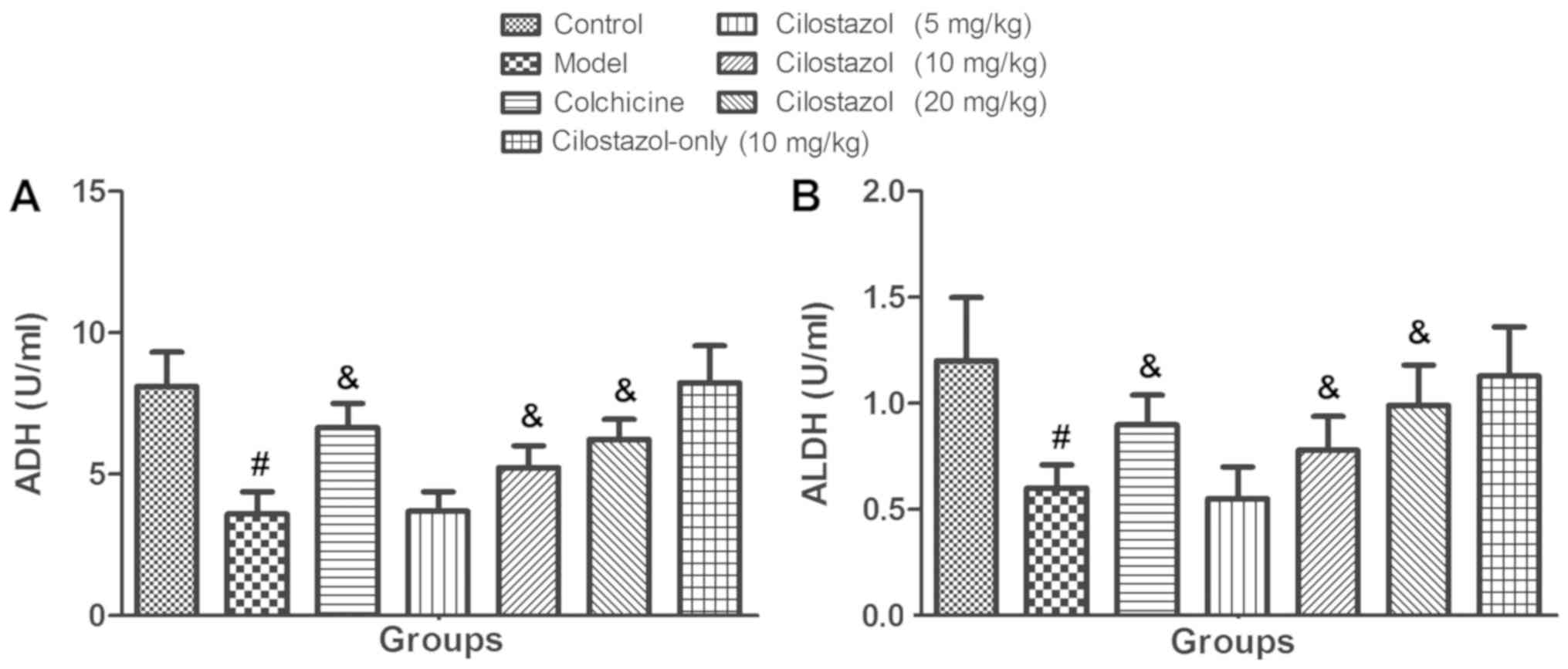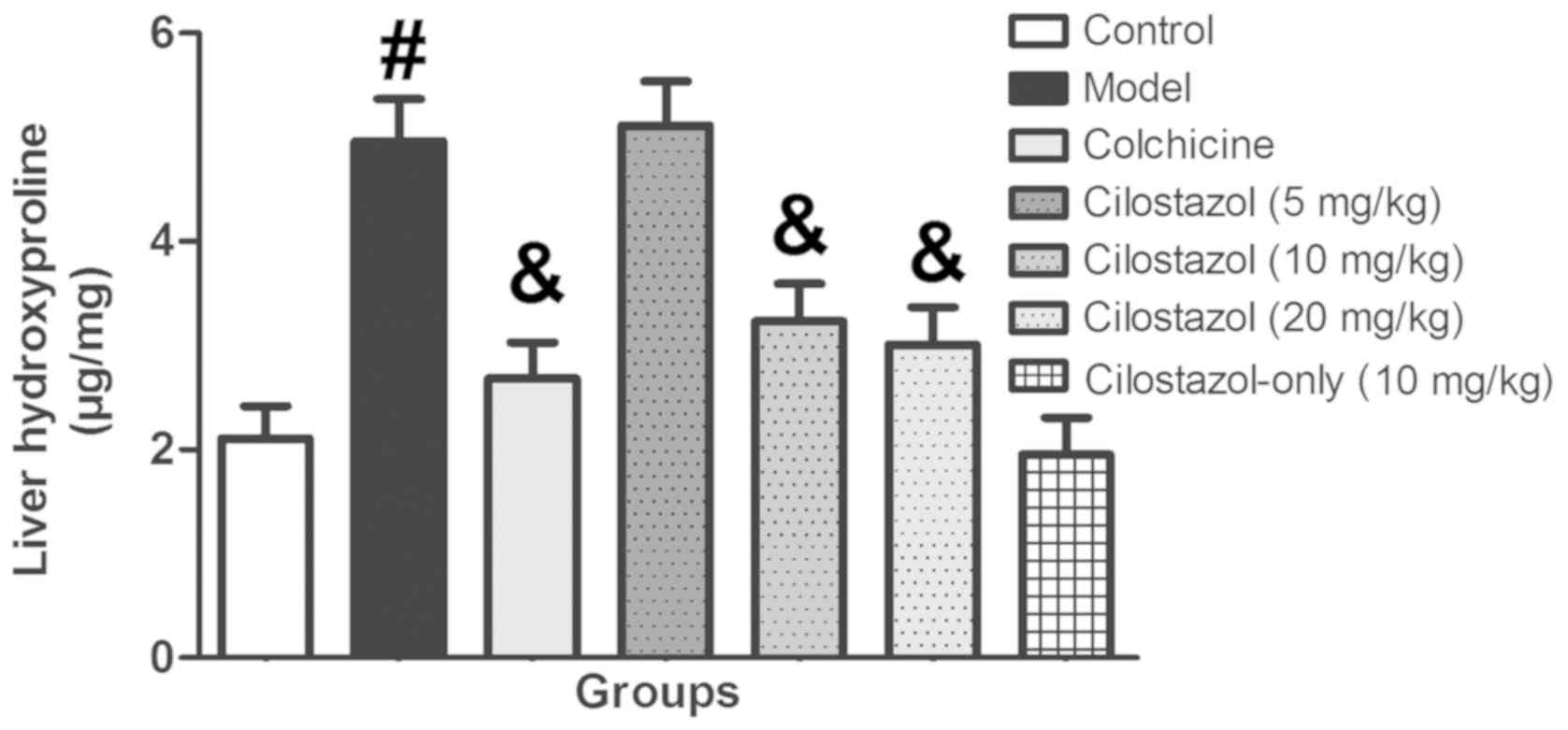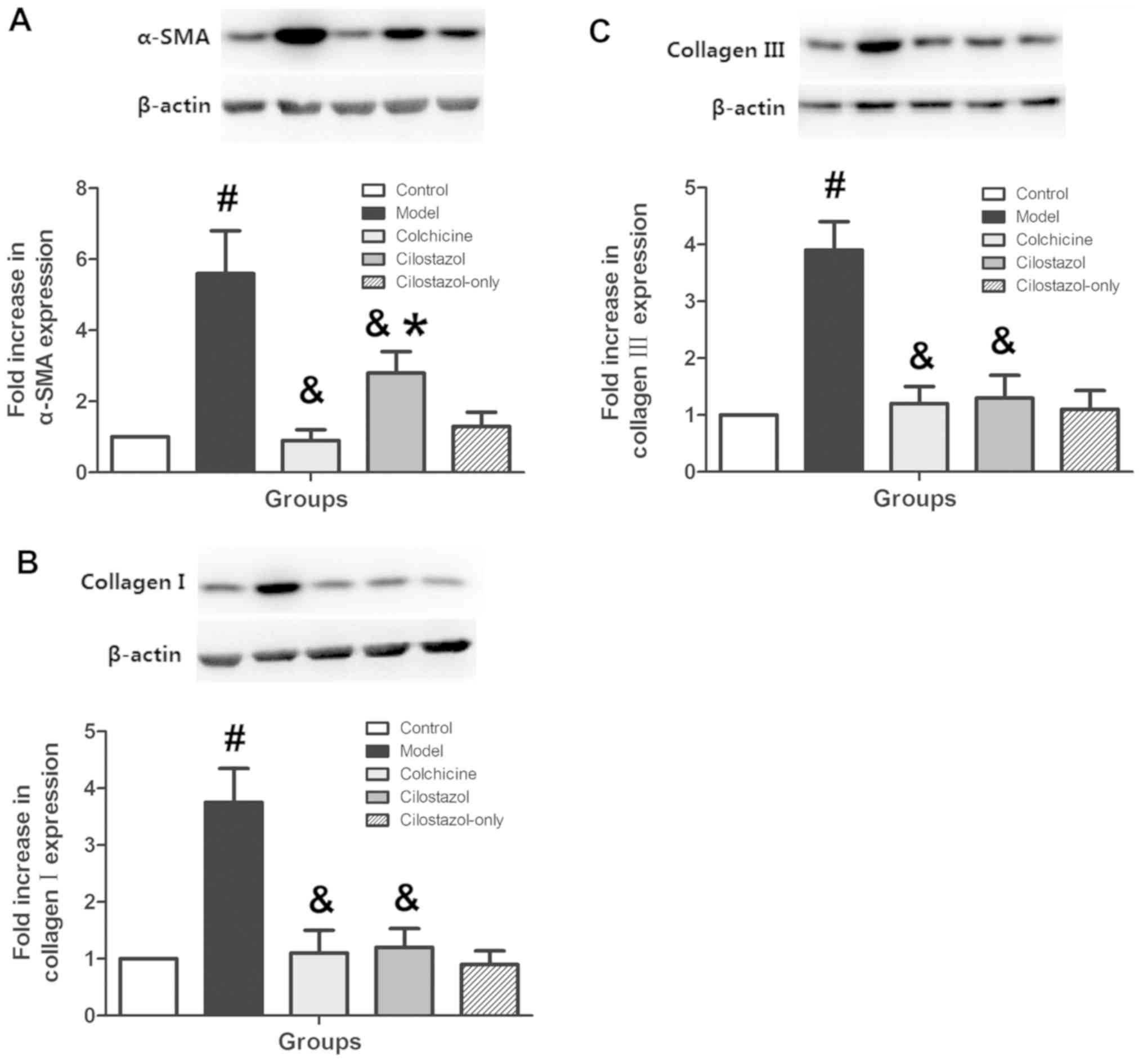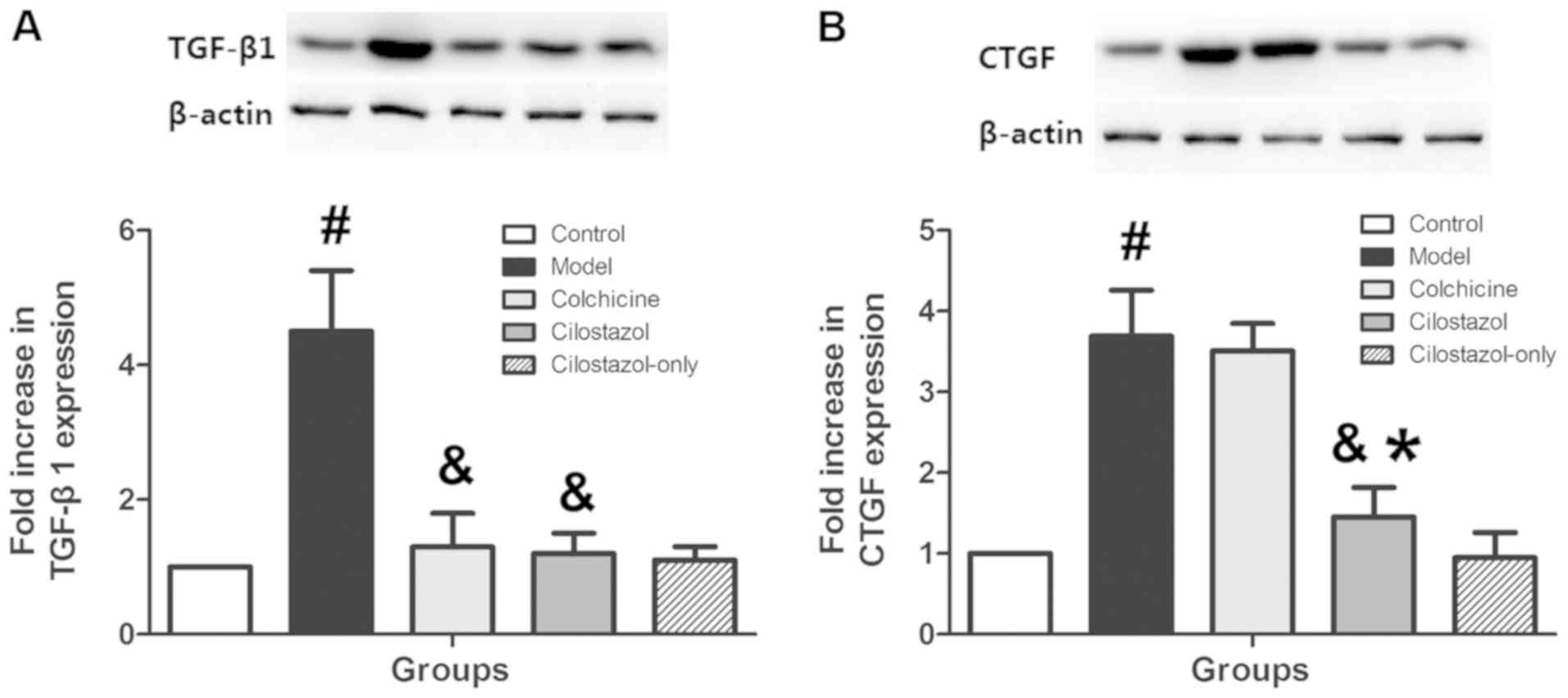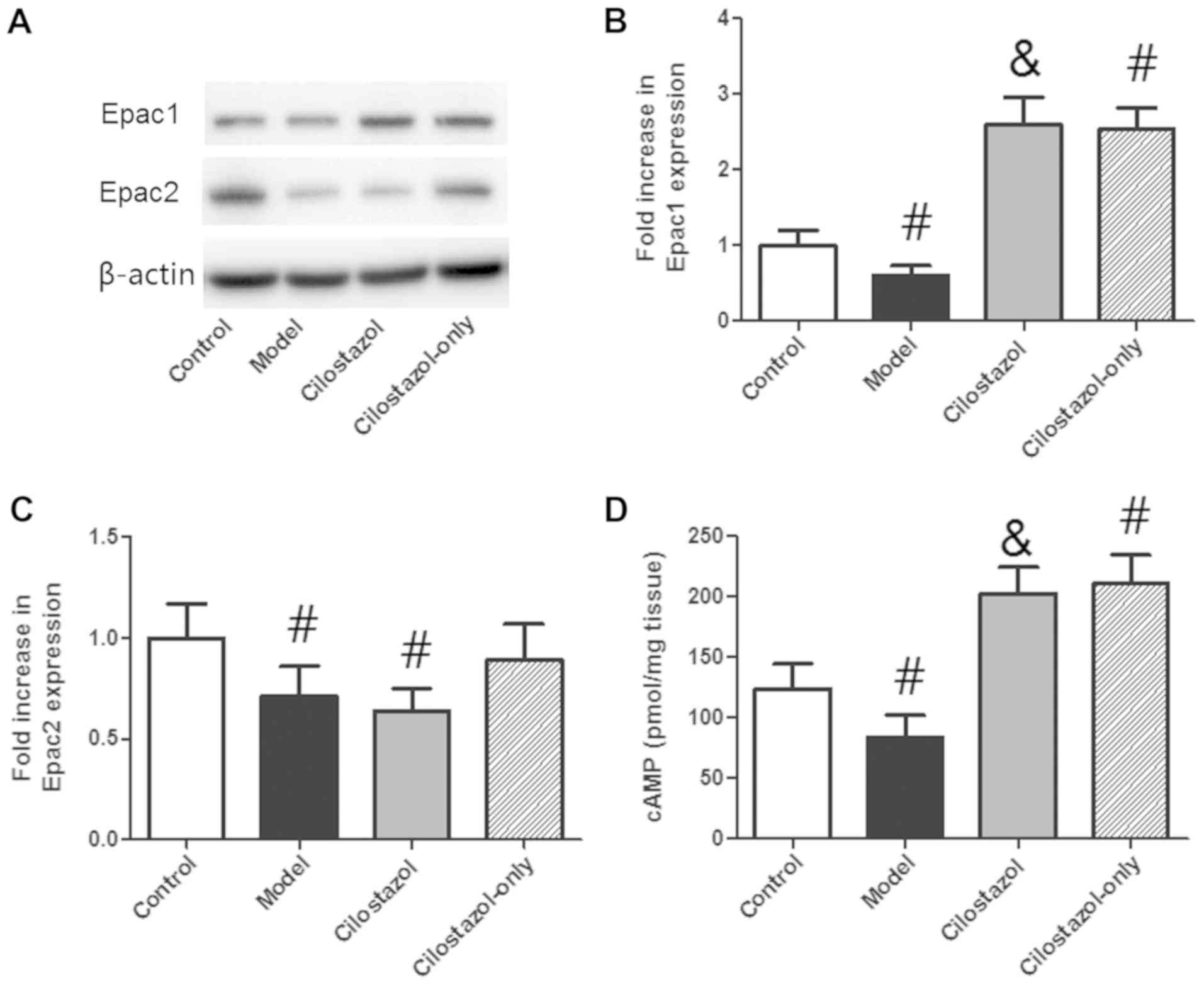|
1
|
Lin X, Zhang S, Huang R, Wei L, Tan S,
Liang S, Tian Y, Wu X, Lu Z and Huang Q: Helenalin attenuates
alcohol-induced hepatic fibrosis by enhancing ethanol metabolism,
inhibiting oxidative stress and suppressing HSC activation.
Fitoterapia. 95:203–213. 2014. View Article : Google Scholar : PubMed/NCBI
|
|
2
|
Duddempudi AT: Immunology in alcoholic
liver disease. Clin Liver Dis. 16:687–698. 2012. View Article : Google Scholar : PubMed/NCBI
|
|
3
|
Kumar M and Sarin SK: Is cirrhosis of the
liver reversible? Indian J Pediatr. 74:393–399. 2007. View Article : Google Scholar : PubMed/NCBI
|
|
4
|
Jayakumar T, Ramesh E and Geraldine P:
Antioxidant activity of the oyster mushroom, Pleurotus ostreatus,
on CCl(4)-induced liver injury in rats. Food Chem Toxicol.
44:1989–1996. 2006. View Article : Google Scholar : PubMed/NCBI
|
|
5
|
Shyu MH, Kao TC and Yen GC: Hsian-tsao
(Mesona procumbens Heml.) prevents against rat liver fibrosis
induced by CCl(4) via inhibition of hepatic stellate cells
activation. Food Chem Toxicol. 46:3707–3713. 2008. View Article : Google Scholar : PubMed/NCBI
|
|
6
|
Ihn H: Pathogenesis of fibrosis: Role of
TGF-beta and CTGF. Curr Opin Rheumatol. 14:681–685. 2002.
View Article : Google Scholar : PubMed/NCBI
|
|
7
|
Marcial JM, Pérez R, Vargas P and
Franqui-Rivera H: Non-invasive therapy of peripheral arterial
disease. Bol Asoc Med P R. 107:52–57. 2015.PubMed/NCBI
|
|
8
|
Abdel Kawy HS: Cilostazol attenuates
cholestatic liver injury and its complications in common bile duct
ligated rats. Eur J Pharmacol. 752:8–17. 2015. View Article : Google Scholar : PubMed/NCBI
|
|
9
|
Saito S, Hata K, Iwaisako K, Yanagida A,
Takeiri M, Tanaka H, Kageyama S, Hirao H, Ikeda K, Asagiri M and
Uemoto S: Cilostazol attenuates hepatic stellate cell activation
and protects mice against carbon tetrachloride-induced liver
fibrosis. Hepatol Res. 44:460–473. 2014. View Article : Google Scholar : PubMed/NCBI
|
|
10
|
Fujita K, Nozaki Y, Wada K, Yoneda M, Endo
H, Takahashi H, Iwasaki T, Inamori M, Abe Y, Kobayashi N, et al:
Effectiveness of antiplatelet drugs against experimental
non-alcoholic fatty liver disease. Gut. 57:1583–1591. 2008.
View Article : Google Scholar : PubMed/NCBI
|
|
11
|
Zhang XH, Yan M, Liu L, Wu TJ, Ma LL and
Wang LX: Expression of discoidin domain receptors (DDR2) in
alcoholic liver fibrosis in rats. Arch Med Res. 41:586–592. 2010.
View Article : Google Scholar : PubMed/NCBI
|
|
12
|
Wang L, Potter JJ, Rennie-Tankersley L,
Novitskiy G, Sipes J and Mezey E: Effects of retinoic acid on the
development of liver fibrosis produced by carbon tetrachloride in
mice. Biochim Biophys Acta. 1772:66–71. 2007. View Article : Google Scholar : PubMed/NCBI
|
|
13
|
Bergman I and Loxley R: New
spectrophotometric method for the determination of proline in
tissue hydrolyzates. Anal Chem. 42:702–706. 1970. View Article : Google Scholar : PubMed/NCBI
|
|
14
|
Miller RA, Chu Q, Xie J, Foretz M, Viollet
B and Birnbaum MJ: Biguanides suppress hepatic glucagon signalling
by decreasing production of cyclic AMP. Nature. 494:256–260. 2013.
View Article : Google Scholar : PubMed/NCBI
|
|
15
|
Purohit V, Gao B and Song BJ: Molecular
mechanisms of alcoholic fatty liver. Alcohol Clin Exp Res.
33:191–205. 2009. View Article : Google Scholar : PubMed/NCBI
|
|
16
|
Magdaleno F, Blajszczak CC and Nieto N:
Key events participating in the pathogenesis of alcoholic liver
disease. Biomolecules. 7(pii): E92017. View Article : Google Scholar : PubMed/NCBI
|
|
17
|
Mello T, Ceni E, Surrenti C and Galli A:
Alcohol induced hepatic fibrosis: Role of acetaldehyde. Mol Aspects
Med. 29:17–21. 2008. View Article : Google Scholar : PubMed/NCBI
|
|
18
|
Hernandez-Gea V and Friedman SL:
Pathogenesis of liver fibrosis. Annu Rev Pathol. 6:425–456. 2011.
View Article : Google Scholar : PubMed/NCBI
|
|
19
|
Luo Z, Liu H, Sun X, Guo R, Cui R, Ma X
and Yan M: RNA interference against discoidin domain receptor 2
ameliorates alcoholic liver disease in rats. PLoS One.
8:e558602013. View Article : Google Scholar : PubMed/NCBI
|
|
20
|
Jelski W, Orywal K and Szmitkowski M:
Effects of H2-blockers on alcohol dehydrogenase (ADH) activity. Pol
Merkur Lekarski. 25:531–533. 2008.(In Polish). PubMed/NCBI
|
|
21
|
Sung CK, Kim SM, Oh CJ, Yang SA, Han BH
and Mo EK: Taraxerone enhances alcohol oxidation via increases of
alcohol dehyderogenase (ADH) and acetaldehyde dehydrogenase (ALDH)
activities and gene expressions. Food Chem Toxicol. 50:2508–2514.
2012. View Article : Google Scholar : PubMed/NCBI
|
|
22
|
Duncan MR, Frazier KS, Abramson S,
Williams S, Klapper H, Huang X and Grotendorst GR: Connective
tissue growth factor mediates transforming growth factor
beta-induced collagen synthesis: Down-regulation by cAMP. FASEB J.
13:1774–1786. 1999. View Article : Google Scholar : PubMed/NCBI
|
|
23
|
Abraham DJ, Shiwen X, Black CM, Sa S, Xu Y
and Leask A: Tumor necrosis factor alpha suppresses the induction
of connective tissue growth factor by transforming growth
factor-beta in normal and scleroderma fibroblasts. J Biol Chem.
275:15220–15225. 2000. View Article : Google Scholar : PubMed/NCBI
|
|
24
|
Chen Y, Blom IE, Sa S, Goldschmeding R,
Abraham DJ and Leask A: CTGF expression in mesangial cells:
Involvement of SMADs, MAP kinase, and PKC. Kidney Int.
62:1149–1159. 2002. View Article : Google Scholar : PubMed/NCBI
|
|
25
|
Hashimoto A, Tanaka M, Takeda S, Ito H and
Nagano K: Cilostazol induces PGI2 production via activation of the
downstream Epac-1/Rap1 signaling cascade to increase intracellular
calcium by PLCε and to activate p44/42 MAPK in human aortic
endothelial cells. PLoS One. 10:e01328352015. View Article : Google Scholar : PubMed/NCBI
|
|
26
|
Lee DH, Lee HR, Shin HK, Park SY, Hong KW,
Kim EK, Bae SS, Lee WS, Rhim BY and Kim CD: Cilostazol enhances
integrin-dependent homing of progenitor cells by activation of
cAMP-dependent protein kinase in synergy with Epac1. J Neurosci
Res. 89:650–660. 2011. View Article : Google Scholar : PubMed/NCBI
|
|
27
|
Ke K, Safder AM, Sul OJ, Suh JH, Joe Y,
Chung HT and Choi HS: Cilostazol attenuates ovariectomy-induced
bone loss by inhibiting osteoclastogenesis. PLoS One.
10:e01248692015. View Article : Google Scholar : PubMed/NCBI
|
|
28
|
Gloerich M and Bos JL: Epac: Defining a
new mechanism for cAMP action. Annu Rev Pharmacol Toxicol.
50:355–375. 2010. View Article : Google Scholar : PubMed/NCBI
|
|
29
|
Grandoch M, Roscioni SS and Schmidt M: The
role of Epac proteins, novel cAMP mediators, in the regulation of
immune, lung and neuronal function. Br J Pharmacol. 159:265–284.
2010. View Article : Google Scholar : PubMed/NCBI
|
|
30
|
Breckler M, Berthouze M, Laurent AC,
Crozatier B, Morel E and Lezoualc'h F: Rap-linked cAMP signaling
Epac proteins: Compartmentation, functioning and disease
implications. Cell Signal. 23:1257–1266. 2011. View Article : Google Scholar : PubMed/NCBI
|
|
31
|
Insel PA, Murray F, Yokoyama U, Romano S,
Yun H, Brown L, Snead A, Lu D and Aroonsakool N: cAMP and Epac in
the regulation of tissue fibrosis. Br J Pharmacol. 166:447–456.
2012. View Article : Google Scholar : PubMed/NCBI
|
|
32
|
Huang DD, Huang HF, Yang Q and Chen XQ:
Liraglutide improves myocardial fibrosis after myocardial
infarction through inhibition of CTGF by activating cAMP in mice.
Eur Rev Med Pharmacol Sci. 22:4648–4656. 2018.PubMed/NCBI
|
|
33
|
Weng L, Wang W, Su X, Huang Y, Su L, Liu
M, Sun Y, Yang B and Zhou H: The effect of cAMP-PKA activation on
TGF-β1-induced profibrotic signaling. Cell Physiol Biochem.
36:1911–1927. 2015. View Article : Google Scholar : PubMed/NCBI
|
|
34
|
Satish L, Gallo PH, Baratz ME, Johnson S
and Kathju S: Reversal of TGF-β1 stimulation of α-smooth muscle
actin and extracellular matrix components by cyclic AMP in
Dupuytren's-derived fibroblasts. BMC Musculoskelet Disord.
12:1132011. View Article : Google Scholar : PubMed/NCBI
|















